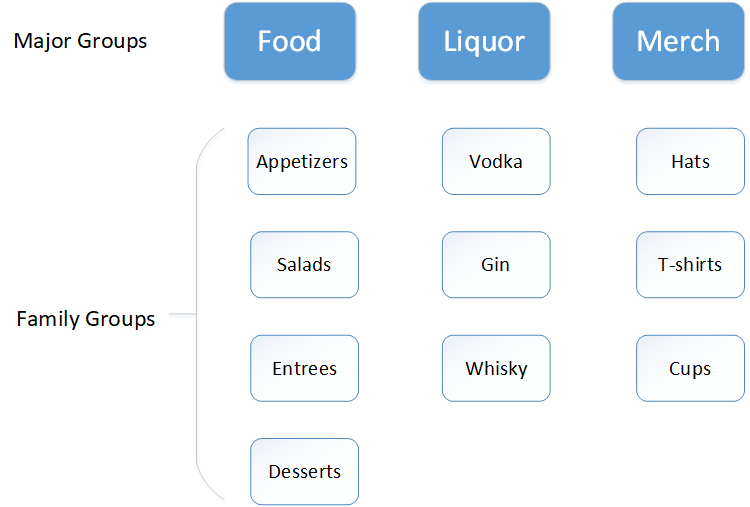Introduction to Menu Items
A menu item is the foundation of transactions. Anything ordered is a menu item. In restaurants, food and drinks are menu items. In retail stores, shirts and hats are also considered menu items. Therefore, any item being sold is a menu item.
Menu item configuration consists of a group of components that are assembled to make the menu item function as needed. The following table shows the menu item components grouped into two categories of tasks: reporting and behavior.
Table 13-1 Menu Item Components
| Reporting Tasks | Behavior Tasks |
|---|---|
|
Major Group |
Menu Item Definition |
|
Family Group |
Menu Item Class |
|
Master Record |
Price Record |
A single menu item can be broken down into six parts that create the whole.
Major Group
A major group is a product category and is the broadest reporting category. Common examples of major groups are food, non-alcoholic beverages, liquor, beer, wine, and retail merchandise. They are used to group items for revenue reporting, such as how much food was sold today or this month.
Family Group
Family groups are smaller groups within the major group to which they belong. Typically, a family group is a subset, or product sub-category, of a specific major group. Common examples of family groups are appetizers, salads, entrées, desserts, vodka, gin, and t-shirts. A family group is more specific in reporting tasks as it helps detail quantities such as burgers sold or bottles of X brand of beer ordered.
The following figure illustrates an example of major groups and family groups.

Master Record
Master records offer the sharpest level of reporting detail as they are the actual menu items themselves. Examples of master records are Cheeseburger, Oracle Suds IPA, and specific pieces of merchandise purchased by customers (hats or shirts). Master records are also the bridge to the behavioral side of the menu item: menu item definition, menu item class, and price record.
Menu Item Definition
Each master record can have up to 64 possible definitions. The definitions begin to diversify a menu item, defining when the item is available by enabling the different menu levels, as well as where the item is available. The definitions bridge to the reporting side of the menu item and also link to the menu item class and to the menu item price.
Menu Item Class
The menu item class is the element of the menu item that defines whether the item requires, or is required by, another item. For example, if the menu item being configured is a cheeseburger, it will likely be configured with a menu item class that requires the guest to select a meat temperature after selecting the burger. When the cheeseburger is ordered, the workstation operator will be prompted to select the meat temperature menu items that were configured to appear on the workstation at that time. In this example, the meat class can be used as the class for any menu item that only requires a meat temperature. If an item requires a meat temp and a cheese choice, that item needs a new class that requires two condiments instead of only one. On the other hand, if the item being configured is a meat temperature such as rare, the item might be given a class that presents itself on the workstation as an option when a burger is ordered. All items that are meat temperatures receive the same class, meaning they all behave the same way and appear for selection when the burger is ordered.
Each menu item class is constructed to fit a business need, and each menu item definition requires and is limited to a single menu item class, without which it does not appear on the workstation.
Price Record
-
Price Record #1: $3.50
-
Price Record #2: $1.50
Prices are mandatory for reporting sold and prep counts, even if the price record is $0.00. If an item does not have a price record, it does not appear on reports and does not deduct from inventory counts. Prep or descriptive menu items, such as “Do Not Make”, “Sunny Side Up”, and “Rare” typically do not receive price records.